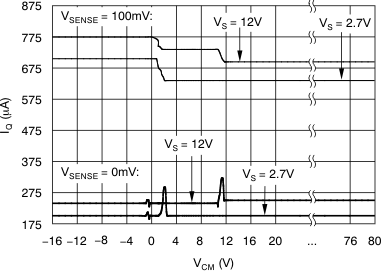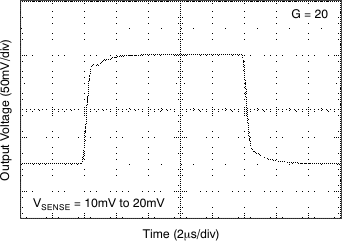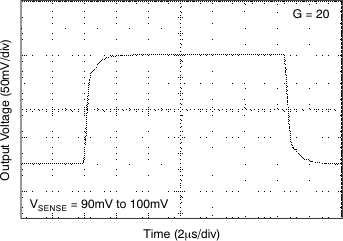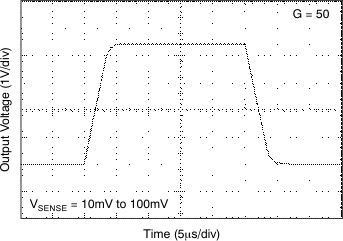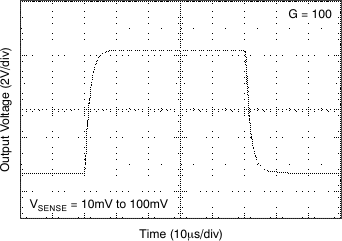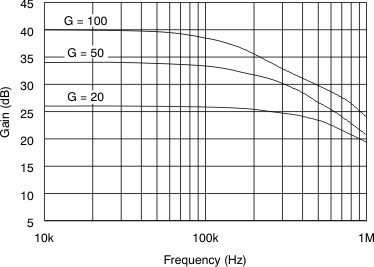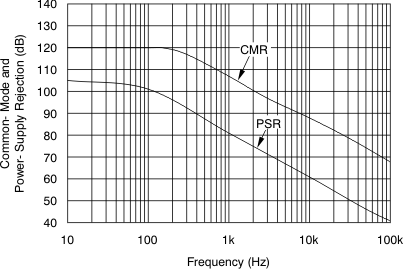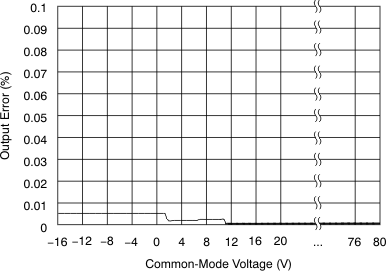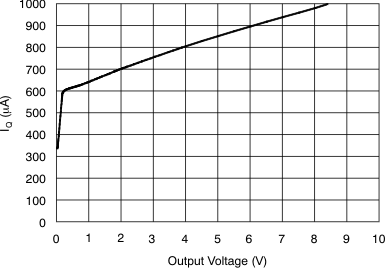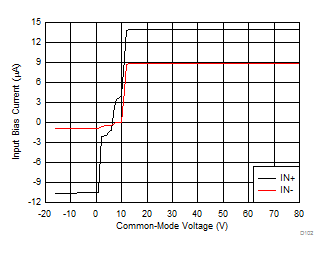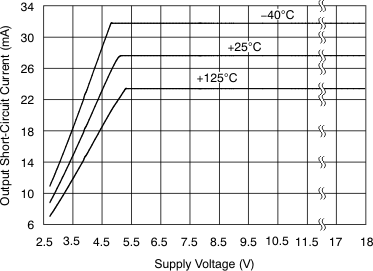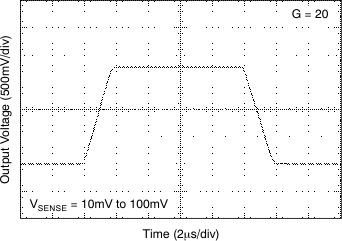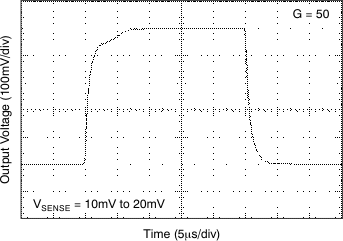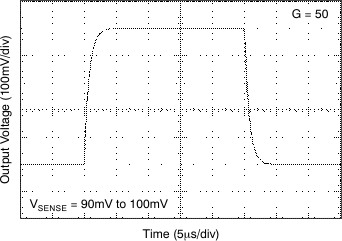SBOS307G May 2004 – January 2015 INA193 , INA194 , INA195 , INA196 , INA197 , INA198
PRODUCTION DATA.
- 1 Features
- 2 Applications
- 3 Description
- 4 Revision History
- 5 Device Comparison Table
- 6 Pin Configuration and Functions
- 7 Specifications
- 8 Detailed Description
- 9 Application and Implementation
- 10Power Supply Recommendations
- 11Layout
- 12Device and Documentation Support
- 13Mechanical, Packaging, and Orderable Information
Package Options
Mechanical Data (Package|Pins)
- DBV|5
Thermal pad, mechanical data (Package|Pins)
Orderable Information
7 Specifications
7.1 Absolute Maximum Ratings
over operating free-air temperature range (unless otherwise noted) (1)| MIN | MAX | UNIT | ||
|---|---|---|---|---|
| Supply Voltage | 18 | V | ||
| Analog Inputs, VIN+, VIN− | –18 | 18 | V | |
| Differential (VIN+) – (VIN−) | –18 | 18 | V | |
| Common-Mode(2) | –16 | 80 | V | |
| Analog Output, Out(2) | GND – 0.3 | (V+) + 0.3 | V | |
| Input Current Into Any Pin(2) | 5 | mA | ||
| Operating Temperature | –55 | 150 | °C | |
| Junction Temperature | 150 | °C | ||
| Storage temperature, Tstg | –65 | 150 | °C | |
(1) Stresses beyond those listed under Absolute Maximum Ratings may cause permanent damage to the device. These are stress ratings only, which do not imply functional operation of the device at these or any other conditions beyond those indicated under Recommended Operating Conditions. Exposure to absolute-maximum-rated conditions for extended periods may affect device reliability.
(2) Input voltage at any pin may exceed the voltage shown if the current at that pin is limited to 5mA.
7.2 ESD Ratings
| VALUE | UNIT | ||||
|---|---|---|---|---|---|
| V(ESD) | Electrostatic discharge | Human body model (HBM), per ANSI/ESDA/JEDEC JS-001, all pins(1) | ±4000 | V | |
| Charged device model (CDM), per JEDEC specification JESD22-C101, all pins(2) | ±1000 | ||||
(1) JEDEC document JEP155 states that 500-V HBM allows safe manufacturing with a standard ESD control process.
(2) JEDEC document JEP157 states that 250-V CDM allows safe manufacturing with a standard ESD control process.
7.3 Recommended Operating Conditions
over operating free-air temperature range (unless otherwise noted)| MIN | NOM | MAX | UNIT | ||
|---|---|---|---|---|---|
| VCM | Common-mode input voltage | 12 | V | ||
| V+ | Operating supply voltage | 12 | V | ||
| TA | Operating free-air temperature | -40 | 125 | ºC | |
7.4 Thermal Information
| THERMAL METRIC(1) | INA19x | UNIT | |
|---|---|---|---|
| DBV (SOT-23) | |||
| 5 PINS | |||
| RθJA | Junction-to-ambient thermal resistance | 221.7 | °C/W |
| RθJC(top) | Junction-to-case (top) thermal resistance | 144.7 | |
| RθJB | Junction-to-board thermal resistance | 49.7 | |
| ψJT | Junction-to-top characterization parameter | 26.1 | |
| ψJB | Junction-to-board characterization parameter | 49.0 | |
(1) For more information about traditional and new thermal metrics, see the IC Package Thermal Metrics application report, SPRA953.
7.5 Electrical Characteristics
All specifications at TA = 25°C, VS = 12 V, VIN+ = 12 V, and VSENSE = 100 mV, unless otherwise noted.| PARAMETER | TEST CONDITIONS | TA = 25°C | TA = −40°C to +125°C | UNIT | ||||||
|---|---|---|---|---|---|---|---|---|---|---|
| MIN | TYP | MAX | MIN | TYP | MAX | |||||
| INPUT | ||||||||||
| VSENSE | Full-Scale Input Voltage | VSENSE = VIN+ − VIN− | 0.15 | (VS – 0.2)/Gain | –16 | V | ||||
| VCM | Common-Mode Input Range | 80 | –16 | V | ||||||
| CMR | Common-Mode Rejection | VIN+ = −16 V to 80 V | 80 | 94 | dB | |||||
| Common-Mode Rejection, Over Temperature | VIN+ = 12 V to 80 V | 100 | 120 | dB | ||||||
| VOS | Offset Voltage, RTI | ±0.5 | 2 | mV | ||||||
| Offset Voltage, RTI Over Temperature | 0.5 | 3 | mV | |||||||
| dVOS/dT | Offset Voltage, RTI vs Temperature | 2.5 | μV/°C | |||||||
| PSR | Offset Voltage, RTI vs Power Supply | VS = 2.7 V to 18 V, VIN+ = 18 V | 5 | 100 | μV/V | |||||
| IB | Input Bias Current, VIN− pin | ±8 | ±16 | μA | ||||||
| OUTPUT (VSENSE ≥ 20mV) | ||||||||||
| G | Gain | INA193, INA196 | 20 | V/V | ||||||
| INA194, INA197 | 50 | V/V | ||||||||
| INA195, INA198 | 100 | V/V | ||||||||
| Gain Error | VSENSE = 20 mV to 100 mV, TA = 25°C |
±0.2% | ±1% | |||||||
| Gain Error Over Temperature | VSENSE = 20 mV to 100 mV | ±2 | ||||||||
| Total Output Error(1) | VSENSE = 100 mV | ±0.75% | ±2.2% | |||||||
| Total Output Error Over Temperature | ±1% | ±3% | ||||||||
| Nonlinearity Error | VSENSE = 20 mV to 100 mV | ±0.002% | ±0.1% | |||||||
| RO | Output Impedance | 1.5 | Ω | |||||||
| Maximum Capacitive Load | No Sustained Oscillation | 10 | nF | |||||||
| Output(4) | All Devices | −16 V ≤ VCM < 0 V, VSENSE < 20 mV | 300 | mV | ||||||
| VS < VCM ≤ 80 V, VSENSE < 20 mV | 300 | |||||||||
| INA193, INA196 | 0 V ≤ VCM ≤ VS, VS = 5 V, VSENSE < 20 mV |
0.4 | V | |||||||
| INA194, INA197 | 1 | V | ||||||||
| INA195, INA198 | 2 | V | ||||||||
| VOLTAGE OUTPUT(2) (RL = 100 kΩ to GND) | ||||||||||
| Swing to V+ Power-Supply Rail | (V+) – 0.1 | (V+) – 0.2 | V | |||||||
| Swing to GND(3) | (VGND) + 3 | (VGND) + 50 | mV | |||||||
| FREQUENCY RESPONSE | ||||||||||
| BW | Bandwidth | INA193, INA196 | CLOAD = 5 pF | 500 | kHz | |||||
| INA194, INA197 | 300 | kHz | ||||||||
| INA195, INA198 | 200 | kHz | ||||||||
| Phase Margin | CLOAD < 10 nF | 40 | ||||||||
| SR | Slew Rate | 1 | V/μs | |||||||
| tS | Settling Time (1%) | VSENSE = 10 mV to 100 mVPP, CLOAD = 5 pF |
2 | μs | ||||||
| NOISE, RTI | ||||||||||
| Voltage Noise Density | 40 | nV/√Hz | ||||||||
| POWER SUPPLY | ||||||||||
| VS | Operating Range | 2.7 | 18 | V | ||||||
| IQ | Quiescent Current | VOUT = 2 V | 700 | 900 | μA | |||||
| Quiescent Current Over Temperature | VSENSE = 0 mV | 370 | 950 | μA | ||||||
| TEMPERATURE RANGE | ||||||||||
| Specified Temperature Range | –40 | 125 | °C | |||||||
| Operating Temperature Range | –55 | 150 | °C | |||||||
| Storage Temperature Range | –65 | 150 | °C | |||||||
| θJA | Thermal Resistance, SOT23 | 200 | °C/W | |||||||
(1) Total output error includes effects of gain error and VOS.
(2) See Typical Characteristic curve Output Swing vs Output Current, Figure 7.
(3) Specified by design.
(4) For details on this region of operation, see the Accuracy Variations as a Result of VSENSE and Common-Mode Voltage section.
7.6 Typical Characteristics
All specifications at TA = 25°C, VS = 12 V, and VIN+ = 12 V, and VSENSE = 100 mV, unless otherwise noted.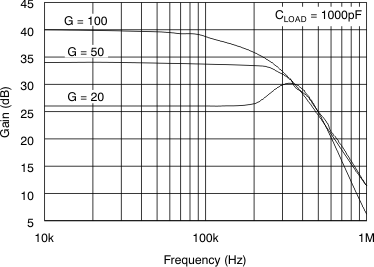
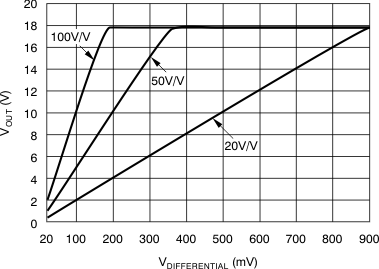
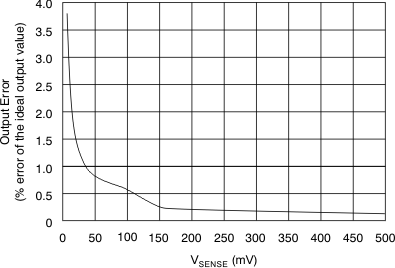
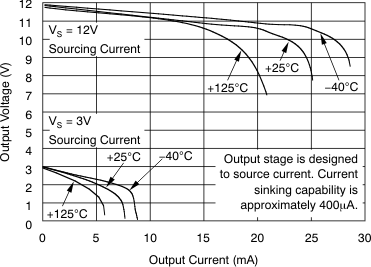
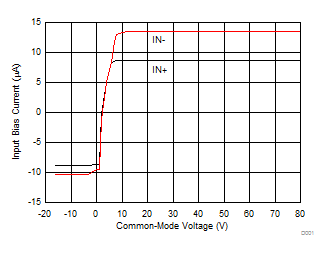
Vs=5 V
